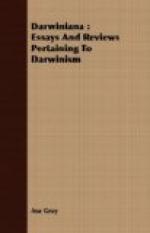The same Sequoia which abounds in the same miocene formations in Northern Europe has been abundantly found in those of Iceland, Spitzbergen, Greenland, Mackenzie River, and Alaska. It is named S. Langsdorfii, but is pronounced to be very much like S. sempervirens, our living redwood of the Californian coast, and to be the ancient representative of it. Fossil specimens of a similar, if not the same, species have recently been detected in the Rocky Mountains by Hayden, and determined by our eminent palaeontological botanist, Lesquereux; and he assures me that he has the common redwood itself from Oregon in a deposit of tertiary age. Another Sequoia (S. Sternbergii), discovered in miocene deposits in Greenland, is pronounced to be the representative of S. gigantea, the big tree of the Californian Sierra. If the Taxodium of the tertiary time in Europe and throughout the arctic regions is the ancestor of our present bald cypress—which is assumed in regarding them as specifically identical— then I think we may, with our present light, fairly assume that the two redwoods of California are the direct or collateral descendants of the two ancient species which so closely resemble them.
The forests of the arctic zone in tertiary times contained at least three other species of Sequoia, as determined by their remains, one of which, from Spitzbergen, also much resembles the common redwood of California. Another, “which appears to have been the commonest coniferous tree on Disco,” was common in England and some other parts of Europe. So the Sequoias, now remarkable for their restricted station and numbers, as well as for their extraordinary size, are of an ancient stock; their ancestors and kindred formed a large part of the forests which flourished throughout the polar regions, now desolate and ice-clad, and which extended into low latitudes in Europe. On this continent one species, at least, had reached to the vicinity of its present habitat before the glaciation of the region. Among the fossil specimens already found in California, but which our trustworthy palaeontological botanist has not yet had time to examine, we may expect to find evidence of the early arrival of these two redwoods upon the ground which they now, after much vicissitude, scantily occupy.
Differences of climate, or circumstances of migration, or both, must have determined the survival of Sequoia upon the Pacific, and of Taxodium upon the Atlantic coast. And still the redwoods will not stand in the east, nor could our Taxodium find a congenial station in California. Both have probably had their opportunity in the olden time, and failed.
As to the remaining near relative of Sequoia, the Chinese Glyptostrobus, a species of it, and its veritable representative, was contemporaneous with Sequoia and Taxodium, not only in temperate Europe, but throughout the arctic regions from Greenland to Alaska. According to Newberry, it was abundantly represented in the miocene flora of the temperate zone of our own continent, from Nebraska to the Pacific.




